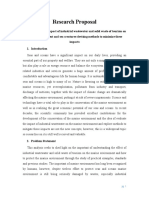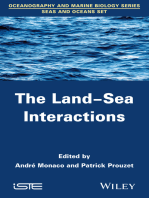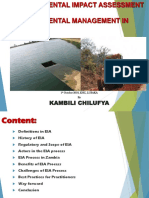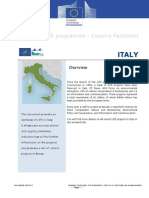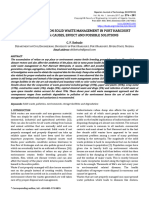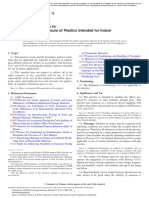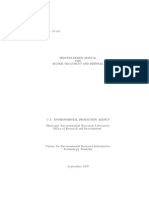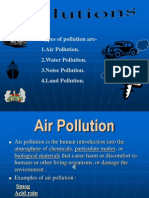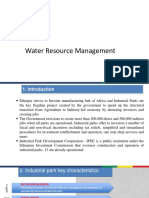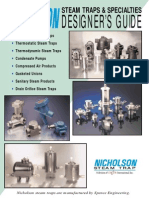Srcosmos
Uploaded by
kkakosimSrcosmos
Uploaded by
kkakosimPOLLUTION RISK ASSESSMENT FROM EUROPEAN MINING SITES AND PRELIMINARY RESULTS FROM TAILINGS DAMS IN GREECE
K. Hadjibiros1, I.D. Mantziaras1, D.G. Sakellariadis1, C. Giannakidou1 and A. Katsiri1
1
Department of Civil Engineering, National Technical University of Athens (NTUA), Iroon Polytechniou 5, 15773 Zografou - Athens, Greece e-mail: k.hadjibiros@itia.ntua.gr
ABSTRACT This work is elaborated in the framework of the EU research project e-EcoRisk, which aims at assessing environmental and social risk of a catastrophic failure of mining tailings dams. The 18 participating groups collect data on threats from tailings dam spills at selected test sites, in mining areas of Greece, Italy, Portugal and Spain. In Greece, the mining areas of Olympias and Stratoni with their associated tailings dams are been examined. The mines are situated in the proximity of ecologically vulnerable areas. The paper aims at a preliminary assessment of potential environmental impact of mining disposals. Sampling has taken place in the tailings dams and in the surrounding aquatic environment. The results constitute an input to further investigation and risk assessment. 1. INTRODUCTION Uncontrolled large-scale discharge of toxic effluent from industrial facilities, such as chemical plants, oil or slurry pipelines and tailings dams pose a serious hazard to the natural environment and to public health and safety. Mine tailings dams constitute one of the greatest threats, because of their high concentration of heavy metals (As, Cd, Cu, Hg, Pb, Zn) and toxic chemicals, environmentally sensitive locations, unstable nature, large number and often poor to non-existent maintenance. Heavy metals can persist in the soil and groundwater over a long period and many of them are bioaccumulative or bio-magnified. This can result in long-term damage to flora and fauna and give rise to detrimental effects in humans, through introduction into the food chain & drinking water system. Many sensitive wetland areas in Europe and elsewhere (e.g., Ramsar, Natura 2000, birds conservation sites) are under threat from large-scale mine tailings dam spills. Environmental and societal impact of these spills, therefore, can be enormous, especially from a socio-economic aspect. Tailings dam failures have caused casualties and considerable environmental damage. Serious accidents have resulted in large volumes of tailings being discharged into the environment. In addition to the risk of catastrophic events, ecological impacts of mining waste give rise to concern among environmental agencies and local communities. Abandoned tailings piles can also release toxic effluents and other potentially hazardous materials into the environment. Ongoing impacts from tailings disposal operations include transport of tailings solids into adjacent environments by wind and water erosion, and pollution of ground and surface water by toxic substances such as dissolved metals, cyanide and sulphates [9].
The position of a mine is fixed by the position of the ore body, but the position for the waste piles may be controlled by environmental considerations, regulations, local hydrological and seismic conditions, as well as geographical and geotechnical conditions. Factors affecting the mine tailings dam safety include: Foundation conditions Ultimate height and angle of the outer slope Rate of deposition and properties of the tailings Provision of adequate drainage Seismic factor Hydrological conditions. Thousands of mine tailings dams are situated in Europe and tens of thousands world-wide, with numerous large-scale spills having occurred until now. In the past two decades, major spills have been reported in Central and Southeast Asia, Australia, Africa, North and South America. Recent spills in Europe have occurred in Sweden, Spain, Italy, Portugal, Bulgaria, Estonia and the UK. However, little is known of the potential harmful impact of a mine tailings spill on environment and society, except in a few well-publicised and documented cases. Two large-scale mine tailings dam failures in Europe, Los Frailes, Spain, 1998, and Baia Mare, Romania, Danube River, 2000, resulted in [9]: Contamination of fisheries, shellfish, grazing and agricultural land and resultant loss in production and markets Contamination of surface and aquifer water and resultant loss in water quality and threat to the health and safety of human and ecological communities Cost of clean-up in the hundreds of millions of euros. In both the Los Frailes and Baia Mare spills, there was a lack of any preventative measures and emergency planning and co-ordination by the authorities prior to and in response after the disasters. Stakeholders and actors should be able to choose a risk reduction strategy from a set of options on the response to a crisis prior to, during, and after a spill event. 2. METHODOLOGY 2.1. A research programme [9] What options are available to lower the likelihood or severity of a spill occurring by instituting preventive, mitigation, control, or other measures aimed at eliminating the cause or reducing the severity of its consequences? The aim of e-Ecorisk research project is to create a regional enterprise network information management and decision-support system to provide information on the potential and actual risks of large-scale spills from mining disposals. It includes integration and analysis of thematic and risk information on potential impact areas of a spill; identification, characterisation, quantification and assessment of the environmental and societal threat, risk, and potential and actual impact of a spill; accessing the system from fixed and mobile-wireless devices via networks (Internet), using terrestrial and satellite telecommunication networks; incorporating advance data and information collection, analysis, visualisation, communication, and management technologies; development and test of a prototype system using data and information obtained from mine tailings dam sites in Greece, Italy, Portugal and Spain. The 18 collaborating European institutes are: Joanneum Research, Institute of Digital Image Processing, Graz, Austria Geosoft Ltd, Leeds, United Kingdom Advanced Computer Systems, Rome, Italy Instituto Superior Tecnico, Centro de Geo-Sistemas, Lisbon, Portugal
Ministerio da Economia, Instituto Nacional de Engenharia, Tecnologia e Inovaco, Lisbon, Portugal Universidade de Aveiro, Departamento de Geosciencias, Aveiro, Portugal Instituto Superior Tecnico, Centro de Estudos de Hidrosistemas, Lisbon, Portugal Consejo Superior de Investigaciones Cientificas, Centro de Ciencias Medioambientales, Madrid, Spain Universidad de Huelva, Departamento de Geologia, Huelva, Spain Universidad de Sevilla, Departamento de Geografia Humana, Sevilla, Spain Tratamientos y Proyectos Medioambientales, Sevilla, Spain Universidad Politecnica de Catalunya, Departamento de Fisica Aplicada, Manresa, Barcelona, Spain Consigliore Nazionale delle Ricerche, Istituto di Agrometeorologia e Analisi Ambientale Applicata allAgricoltura, Florence, Italy Fondazione per la Meteorologia Applicata, Laboratorio per la Meteorologia a la Modellistica Ambientale, Florence, Italy Consigliore Nazionale delle Ricerche, Centro di Studi Geominerari e Mineralurgici, Cagliari, Italy Univerisita di Cagliari, Dipartimento di Geoingegneria e Tecnologie Ambientali, Cagliari, Italy Aristotle University, Department of Mineralogy, Petrology, and Economic Geology, Thessaloniki, Greece National Technical University of Athens, Department of Water Resources, Hydraulic and Maritime Engineering, Athens, Greece. The elements of the approach are: end-user requirements, field data collection, remote sensing data analysis, dam break and surface discharge modelling, socio-economic impact and cost-benefit analysis, risk analysis, information management and decision-support system. The satellite Earth observation and the field data provide synoptic information on the threatened downstream environmental and societal elements. They derive high resolution digital models, to identify and characterise the topographic and terrain features and factors controlling the dispersion of a spill. The case study characterisation may include: General description and characterisation of the tailings dam basin, basin volume and geometry, existing discharge, geologic cross sections Sediment characterisation, mineralogical and chemical composition, grain size, water content, porosity, permeability coefficient, internal friction angle, cohesion, viscosity Dam characterisation, cross section, total length, material grain size, safety factor, history of the dam rising Down stream valley morphology, major channels, flow rates, socio-economic data Ecological characterisation of the downstream valley, protected areas, presence and distribution of vulnerable species Groundwater parameters, simplified hydrogeologic map, recharge area. The dam break and surface discharge models represent the dispersion of effluent into a landscape setting under various spill scenarios through modelling of inundation areas, using topographic, environmental and societal input data. The object is to predict: the potential discharge routing; the flood parameters; the extent of dispersal of sediment material in the downstream valley; the discharge of fluid composed by water and sediment.
The socio-economic approach analyses social, economic, legal, and political aspects of the risks to society and evaluates the economic cost factors, e.g. clean-up, property damage, loss of business, impaired health and safety. The risk analysis assesses the potential environmental and societal impact to downstream areas threatened by a spill. It identifies and evaluates hazard, vulnerability and possible consequences, leading to an improved risk management. A database of historical mine spill disasters in Europe will be built, including empirical data on tailings dam characteristics, dam break cause and type, sludge travel distance and impacted area. The information will be based on bibliographical sources and e-Ecorisk partners contribution. A statistical analysis will be applied to the historical disasters database and, in this context, an analysis of e-Ecorisk test sites will follow. A geographic database will store, process and access decision-support information of a threatened area. There will be high-speed access to the decision-support system through the Internet. 3. PRELIMINARY RESULTS 3. 1. Data collection in four countries of Southern Europe 3.1.1. The Portuguese mine test sites [9] Aljustrel Mine. The mine is located in the Iberian Pyrite Belt, it is one of its biggest deposits (> 200 Mt). There are polymetallic massive sulphides orebodies containing Zn, Cu, Pb, Ag, Au. Surface and underground exploitation was suspended in 1993. The total amount of waste stored on the site exceeds 3Mt. There was direct discharge of acid waters in some streams. It is in stand by to restart exploitation, with maintenance operations. Panasqueira Mine. An open mine, in activity since 1896 in an area about 21 sq. km. The exploitation is underground. The main product is W, by-products are Sn and Cu, there are also significant amounts of Ag. A small mining village exists in the area and also some villages around. Coarse materials and sands are disposed in tailings and slush in dams. The water of the main river flowing in the area is part of the water supply to the Lisbon city. 3. 1. 2. The Italian mine test sites [9] Gavorrano in Tuscany. The area is part of a Colline Metallifere, a gently rugged area placed almost in the middle of Tuscany. The land is mainly covered by deciduous or semi-deciduous woods, while various cereal crops are grown in sparse fields. It is a mining area where iron, copper and other metals have been extracted since ancient times. Toxic residual sludges from past activity have been stored in tailings dams and in abandoned galleries. Present environmental risks include possible tailings dam spills, progressive washing of toxic metals into streams and rivers, infiltration of toxic metals into water tables. Actually, most streams and rivers in the area are polluted with Fe, Al, As, Hg, Cd and other toxic metals. Montevecchio in Sardinia. The mine has been in activity from 1628 until 1990. The mining district includes various mines along a big vein deposit (about 10 km in length) with four processing plants and various dams (most of them emptied or eroded). Useful products were lead, zinc and silver. In case of dam failure, the endangered zone includes Oristano gulf (fisheries) and Piscinas beach. Masua in Sardinia. The ore body has a mass of about 7.5 Mt and contains massive mineralization of syngenetic origin hosted in Cambrian dolomite-limestone complex. The mine has been in activity from 1863 to 1987. Useful products were lead and zinc. Campo Pisano in Sardinia. It is a narrow valley with shale and limestone. There are lead and zinc concentrates. 3.1.3. The Spanish mine test sites [9] The Aznalcllar case. On the 25 April 1998, after a failure of the tailings dam, there has been a toxic flow 40 km downstream, 4600 ha of land have been polluted. An important operation of environmental restoration has been realised. Today the mine is closed. Almagrera tailings dams. There are two dams (1.- 1,2 Hm3 and 2.- 1,4 Hm3). The polluted water and mud contain heavy metals (Fe, Cu, Zn, Pb, S, As, Cd ).
Riotinto tailings dams. There are two dams: Embalse del Cobre (> 30 Hm3) and Embalse del Gossan (~22 Hm3). The polluted water and slurries contain toxic elements (Fe, Cu, Zn, Pb, S, As). Downstream of these dams is the Odiel Estuary, 72 sq. km of wetlands and about one third of the European population of spoonbill (400 breeding pairs). 3. 1. 4. The Greek test sites: Olympias and Stratoni mines [4,9] In Chalkidiki the mining process has begun at the 8th B.C. century. The installations of Stratoni and Olympias mines are situated in the wider region of Eastern Chalkidiki, where the main ecosystems are forests and agricultural areas, as well as natural pasture lands. Low and medium mountainous volumes that reach up to the sea characterize the whole region. The area has high ecological interest mainly because of the ecosystems of open forest and maquis at Stratoniko mountain that has been characterized as a Natura 2000 site. There are small river ecosystems, which are extended at length of main creeks; probably, their freshwater is influenced by the mining activity. The flows of the creeks vary considerably between the winter and the summer period. The most important streams are Mavrolakkas in Olympias and Asprolakkas in Stratoni. They both end to wide sea gulfs; renewal of the golf water is fast, therefore the concentrations of heavy metals remain low. The older method of excavation was the reverse sub-level caving, while from 1989-90 the method used is that of excavation and backfill in the exploitation void (lithogomosis) with the tailings that emanate from the flotation tank and after the mixture with cement and water. In this way, the voids in the mine caves are avoided and the consecutive disturbances (cracks and landslides) in the overlying surface are reduced, while the penetration of air and polluted water is limited. With the mixture of cement in the material, alkaline substances are added in the mine waters. The volume of solid waste deposits is limited to 40-50% of the initially excavated material [1]. The annual excavation (until 1992) from the Olympias mine was 170 Kt, and for 1993 it was 130 Kt. In 1993 from the mines Madem Lakkos and Mavres Petres in Stratoni 300 Kt have been excavated. In the past the condensate of the iron-pyrite was exported, but in the last few years it is stored in the area of the enrichment installations so that it can be used as raw material in the case of gold metallurgy [2]. The collected reserve contains 23grAu/ton. The tailings in the flotation lagoon contain 2-3grAu/ton and their exploitation is planned for the near future. The iron-pyrite condensate, after the roasting process, was put back in the mine area as red mud (oxides of iron) and deposited along the banks of the stream Kokkinolakkas. Today, iron-pyrite and arsenic-pyrite are found mainly in the unexploited piles and in the tailings of enrichment as by-products. The potential acidic flow that probably takes place in the deposited piles of the condensate of auriferous iron pyrite - arsenic pyrite in the wider area may release toxic elements and heavy metals [3]. Waste from the enrichment process also contains a variety of toxic substances (Cd, As, Pb, Hg, Cr, Cu, Ni, CN...). 3.2 Discussion of chemical analysis results from Chalkidiki tailings dams The chemical analysis of the samples, reported elsewhere [4], taken in the period 2004-2005 lead to the following findings (cyanide was used in the enrichment process, but was not measured in this work): The tailings contain high concentrations of Pb, As, Cd and Zn. In the Olympias dam, the concentration of Pb is 3 to 9 times and that of As roughly 40 times above limit values of EPA [10] shown in table 1. In the Stratoni dam, the concentration of Pb is 10 to 15 times and that of As 7 to 35 times above limit values. In a total of 15 measured samples, only 2 samples for Cd and only one sample for Zn exceeded the limits. In the stream Mavrolakkas, only As concentrations were found to exceed the drinking water limit established by the EC Directive 98/83 for (10 g/lt). In wet period (January), values between 25 and 45 g/lt were measured, while in dry period (August), the concentrations varied between 53 and 60 g/lt.
The elements Pb, Cd and As present the more serious danger in the particular case, due to their toxicity, high concentrations and wide distribution. Heavy metals are dangerous in the form of their ions and when they are connected with small chains of carbon atoms. Biochemically, toxic action is related to the powerful relationship of the metals ions with sulphur. Thus the SH groups, which are often presented in the ferments that control the rate of critical metabolic reactions in the human body, are linked easily with the cations or with molecules that contain metals; the ferment cannot act physiologically and thus the organism is offended. The toxicity of the heavy metals strongly depends on the chemical form of the element (speciation). The soluble forms are the most dangerous, while the forms that are almost completely insoluble pass through the human body without damage [7]. The pH of the tailings was found in the region of neutrality (6,70 -7,60), consequently Pb is not expected to be present in its toxic ion form. In Chalkidiki mines, PbS is found mainly in the unexploited piles that are deposited in the area of installations, or in the tailings of enrichment. Under the influence of atmospheric oxygen, rainwater, sulphur bacteria and iron bacteria, the sulphur minerals of the piles can be oxidised and release acidic water that contains sulphuric acid (H2SO4) and the soluble bivalent toxic forms of oxidised Pb. The As is very toxic in inorganic forms, but relatively harmless as arsenicbetaine (a usual form of arsenic found in fishes). Under the influence of the above-mentioned factors, the iron pyritearsenic pyrite of piles can be oxidised and release acidic water containing sulphuric acid (H2SO4) and the soluble ion toxic forms of oxidised arsenic. This problem is met in areas of exploitation of mixed sulphides [6]. In reductive conditions, the arsenic salt becomes arsenite (AsO3-3 or AsO2), which is toxic and soluble in water. Depending on the prevailing conditions, it is likely that arsine (AsH3) and methylarsine As(CH3)3 are produced; these gaseous compounds are considered very toxic, when been inhaled. In order to assess the potential toxicity of the samples and the availability of heavy metals to the environment, a sequential extraction procedure was carried out according to the method described by Tessier et al [8]. The total metal concentration was sequentially partitioned in 5 fractions: (1) exchangeable, (2) bound to carbonates, (3) bound to iron and manganese oxides, (4) bound to organic matter and (5) residual. Fraction (1) comprises the easily exchangeable trace metals due to sorption/desorption processes; fraction (2) comprises metals that are susceptible to changes in the pH; fraction (3) comprises iron and manganese oxides which would be unstable under anoxic conditions and fraction (4) comprises metals bound to organic matter that could be released in natural waters under oxidizing conditions following degradation of organic matter by microorganisms. Fraction (5) represents the stable part of metals bound within the crystal structure. Typical results for one sample from the Stratoni dam are shown in Table 1. Table 1 Potentially available forms of metals in sediment samples from the Stratoni dam Fraction Exchangeable (%) Bound to carbonates (%) Bound to Mn and Fe oxides (%) Bound to organic matter (%) Residual (%) Total potentially toxic forms Total concentration, (mg/kg dm) EPA limit (mg/kg dm*) Heavy Metal Pb 0,13 10 25 5,5 59,37 40,63 22650 1500
Cd 13,5 24,5 22 9,5 30,5 69.5 108.5 100
Zn 0,75 30 22,5 16,5 30,25 69,75 22875 35000
*dm = dry matter Cadmium has the highest percentage among the three metals studied in exchangeable form, meaning that it will be readily available to the environment. On the other hand, lead has the lowest toxic potential, 40,6%, against 70% for cadmium and zinc. In case of environmental changes in pH and oxygen concentration, approximately 60% of cadmium, 35% of lead and 53% of zinc would become soluble and thus available to microorganisms. In spite of its relatively low availability, lead could still present a problem to the environment due to its very high concentration. 3.3 Risk Assessment The EPA's Code of Environmental Compliance for Environmental Authorities for High Hazard Dams containing Hazardous Waste [10], has categorized dams on the basis of environmental risk. To determine which category a dam falls into, the following questions must be satisfied: a) does the dam contain hazardous waste? and b) is the dam a high hazard dam? The answer to the first question is positive if the concentrations of heavy metals in the tailings exceed any of the criteria mentioned in the Code. The answer to the second question is positive only if the dam contains hazardous waste and one or more of the following situations occur: i) in the event of dam failure or overflow, the dam's content is flowing to a sensitive or commercial place or it is flowing to a riverine area containing permanent water or it does contaminate a water supply for human consumption or for stock ii) the dam is located within a declared catchment or sub artesian area or watercourse and the dam's surface area exceeds 1 ha, iii) the dam has a surface area greater than 2ha. According to this approach, the tailings dams in Chalkidiki can be considered as high hazard dams containing hazardous waste. Both dams contain at least one heavy metal in total concentration much higher than the EPA limits. In case of failure of these dams, the toxic content will be scattered in the surrounding environment; with the continuous change of conditions, it is highly probable that finally most of the heavy metals will become environmentally available and hence dangerous (short term risk). The long term risk is related to the leakage of pollutants from the mining barrens that remain in the wider region or from the tailings dams [4]. In this case the solubility of metals and hence their various soluble toxic forms will play an important role. 4. CONCLUSIONS The information management and decision-support system (e-Ecorisk) will provide useful information on the prevention, mitigation, and control of spills. The information on a potential or actual spill will be more readily available to civil protection agencies, particularly in emergency situations. It will enhance decision-making related to pre-disaster activities, emergency management and post-disaster activities. It will increase public perception and awareness of the dangers that industrial spills pose to ecosystems and society and thereby permit public participation in the decision-making and risk management process. As regards to Chalkidiki mining region, both dams can be considered as high hazard dams; an emergency situation cannot be excluded in the future, therefore information provided by e-Ecorisk expected results will constitute a valuable tool. REFERENCES
1. Adam K. and B. Gazea (1994) Environmental impacts from the exploitation of mixed sulphide minerals in Stratoni and Olympias, GeoTechnical Chamber of Greece, 13 May, Gerakini, Greece. 2. Beranis N. (1994) Geological structure and raw mining material in the Chalkidiki region in Greece, Thessalonica, Institute of Geological and Mineral Research, Greece. 3. Beranis N. and I. Meladiotis I (1996) Toxic elements and heavy metal concentrations in surface and ground water of Olympias area in the Chalkidiki region, MMX, Vol. 1, p.4961. 4. Hadjibiros K., I.D. Mantziaras, D.G. Sakellariadis and Ch. Giannakidou (2005) Preliminary pollution risk assessment from polymetallic sulphide mining disposals. Proc. 9th Int. Conf. on Environmental Science and Technology, University of the Aegean, Rhodes, pp. 544-552. 5. Kaminaridis L. (1987) Contribution of AEEXP and of the Kassandra mines in the development of mining wealth in the Chalkidiki region in Greece, Congress for the development of Chalkidiki region, Thessalonica. 6. Kontopoulos A. (1993) Prediction, protective and remedial action against acid mine drainage in NE Chalkidiki area, Project CEE No BRE-CT-92-0361, Report. 7. Kouimtzis Th. (1998) Environmental chemistry, University Studio Press, Athens 8. Tessier A., P.G.C. Cambell and M. Bisson (1979) Sequential extraction procedure for the speciation of particulate trace metals, Analytical Chemistry, Vol 50 No 7, pp 844- 851. 9. www.e-ecorisk.info/ 10 US EPA, Code of Environmental Compliance for Environmental Authorities for High Hazard Dams containing Hazardous Waste, URL: www.epa.qld.gov.au/ publications/ p00453aa.pdf/
You might also like
- Integration of Spatial Analysis and Ecological Risk Assessment in A Gis Environment The Case Study of The Venetian Lagoon Contaminated SedimentsNo ratings yetIntegration of Spatial Analysis and Ecological Risk Assessment in A Gis Environment The Case Study of The Venetian Lagoon Contaminated Sediments12 pages
- An Integrated Investigation of The Rio Tailings - Panasqueira Mine (Centre Portugal)No ratings yetAn Integrated Investigation of The Rio Tailings - Panasqueira Mine (Centre Portugal)24 pages
- Groundwater Engineering - A Technical Approach To Hydrogeology, Contaminant Transport and Groundwater Remediation (2019) PDF100% (1)Groundwater Engineering - A Technical Approach To Hydrogeology, Contaminant Transport and Groundwater Remediation (2019) PDF445 pages
- Estudio Integral Mina de W Panasqueira PortugalNo ratings yetEstudio Integral Mina de W Panasqueira Portugal14 pages
- Reducing Disaster Risks Through Science: Issues and ActionsNo ratings yetReducing Disaster Risks Through Science: Issues and Actions32 pages
- Flood Risk Assessment: A Methodological Framework: July 2007No ratings yetFlood Risk Assessment: A Methodological Framework: July 200711 pages
- Other Types of Pollution (20241026143843)No ratings yetOther Types of Pollution (20241026143843)15 pages
- Environmental Engineering Is The Application of Science Andengineering Principles To Improve The Environment (Air, Water, And/or Land Resources)No ratings yetEnvironmental Engineering Is The Application of Science Andengineering Principles To Improve The Environment (Air, Water, And/or Land Resources)19 pages
- Strady-Et-Al-2021-Baseline - PP Phan Tich VI NhuaNo ratings yetStrady-Et-Al-2021-Baseline - PP Phan Tich VI Nhua10 pages
- Overview of Toxic Cyanobacteria and Cyanotoxins in Ibero-American FreshwatersNo ratings yetOverview of Toxic Cyanobacteria and Cyanotoxins in Ibero-American Freshwaters30 pages
- Geosciences Studies in Environmental StudiesNo ratings yetGeosciences Studies in Environmental Studies4 pages
- ENVIRONMENTAL EFFECTS OF PORT ACTIVITIES IN COTONOU, BENIN (WEST AFRICA)No ratings yetENVIRONMENTAL EFFECTS OF PORT ACTIVITIES IN COTONOU, BENIN (WEST AFRICA)13 pages
- Journal of Environmental and Public Health - 2013 - Panagos - Contaminated Sites in Europe Review of the Current SituationNo ratings yetJournal of Environmental and Public Health - 2013 - Panagos - Contaminated Sites in Europe Review of the Current Situation11 pages
- Minerals: Mining Waste and Its Sustainable Management: Advances in Worldwide ResearchNo ratings yetMinerals: Mining Waste and Its Sustainable Management: Advances in Worldwide Research27 pages
- Environmental Hydraulics Two Volume Set Proceedings of the 6th International Symposium on Enviornmental Hydraulics Athens Greece 23 25 June 2010 1st Edition George C. Christodoulou (Editor) - Quickly access the ebook and start reading today100% (2)Environmental Hydraulics Two Volume Set Proceedings of the 6th International Symposium on Enviornmental Hydraulics Athens Greece 23 25 June 2010 1st Edition George C. Christodoulou (Editor) - Quickly access the ebook and start reading today47 pages
- Types, Occurrence, and Distribution of Microplastics and Metals Contamination in Sediments From South West of Kerkennah Archipelago, TunisiaNo ratings yetTypes, Occurrence, and Distribution of Microplastics and Metals Contamination in Sediments From South West of Kerkennah Archipelago, Tunisia13 pages
- Microplastics in the surface water of urban lakes in central Vietnam_ Pollution level, characteristics, and ecological risk assessmentNo ratings yetMicroplastics in the surface water of urban lakes in central Vietnam_ Pollution level, characteristics, and ecological risk assessment11 pages
- Adaptations of Coastal Cities To Global Warming, Sea Level Rise, Climate Change and Endemic Hazards-Springer International Publishing (20No ratings yetAdaptations of Coastal Cities To Global Warming, Sea Level Rise, Climate Change and Endemic Hazards-Springer International Publishing (2090 pages
- Global Drought Trends and Future ProjectionsNo ratings yetGlobal Drought Trends and Future Projections23 pages
- ERC Newsletter September 2013 - Research in SpotlightNo ratings yetERC Newsletter September 2013 - Research in Spotlight4 pages
- Download Complete Environmental Hydraulics Two Volume Set Proceedings of the 6th International Symposium on Enviornmental Hydraulics Athens Greece 23 25 June 2010 1st Edition George C. Christodoulou (Editor) PDF for All Chapters100% (8)Download Complete Environmental Hydraulics Two Volume Set Proceedings of the 6th International Symposium on Enviornmental Hydraulics Athens Greece 23 25 June 2010 1st Edition George C. Christodoulou (Editor) PDF for All Chapters85 pages
- Climate Change Impact On Land Degradation and Desertification in The European Mediterranean Region The Role of The International CooperationNo ratings yetClimate Change Impact On Land Degradation and Desertification in The European Mediterranean Region The Role of The International Cooperation23 pages
- Addressing_the_Insufficiency_of_Marine_Outfall_RegNo ratings yetAddressing_the_Insufficiency_of_Marine_Outfall_Reg29 pages
- Trends in marine pollution mitigation technologies Scientometric analysis of published literature (1990-2022)No ratings yetTrends in marine pollution mitigation technologies Scientometric analysis of published literature (1990-2022)15 pages
- Ajol File Journals - 483 - Articles - 150253 - Submission - Proof - 150253 5701 394961 1 10 20170120No ratings yetAjol File Journals - 483 - Articles - 150253 - Submission - Proof - 150253 5701 394961 1 10 201701206 pages
- ASTM G156.37902 Standard Practice For Selecting and Characterizing Weathering Reference Materials PDF100% (1)ASTM G156.37902 Standard Practice For Selecting and Characterizing Weathering Reference Materials PDF4 pages
- CHEN/SENG 460/660, Quantitative Risk Analysis in Safety Engineering SyllabusNo ratings yetCHEN/SENG 460/660, Quantitative Risk Analysis in Safety Engineering Syllabus9 pages
- ASTM D4459.6249 Standard Practice For Xenon-Arc Exposure of Plastics Intended For Indoor Applications PDFNo ratings yetASTM D4459.6249 Standard Practice For Xenon-Arc Exposure of Plastics Intended For Indoor Applications PDF4 pages
- Civil Engg. (BE) - Project Topics For Students50% (2)Civil Engg. (BE) - Project Topics For Students38 pages
- Types of Pollution Are-1.air Pollution. 2.water Pollution. 3.noise Pollution. 4.land PollutionNo ratings yetTypes of Pollution Are-1.air Pollution. 2.water Pollution. 3.noise Pollution. 4.land Pollution14 pages
- CBSE-X Science - Chap-13 (Our Environment)No ratings yetCBSE-X Science - Chap-13 (Our Environment)12 pages
- Question: As Law Students, How Do You Address The Environmental Problems? A. Local Level B. National Level C. International LevelNo ratings yetQuestion: As Law Students, How Do You Address The Environmental Problems? A. Local Level B. National Level C. International Level7 pages
- CVL 100 Lecture1 Water FINALVER 31jan2019 PDFNo ratings yetCVL 100 Lecture1 Water FINALVER 31jan2019 PDF68 pages
- SEPMUNICIPALITY OF DUMARANfinalwithipprofileNo ratings yetSEPMUNICIPALITY OF DUMARANfinalwithipprofile97 pages
- Integration of Spatial Analysis and Ecological Risk Assessment in A Gis Environment The Case Study of The Venetian Lagoon Contaminated SedimentsIntegration of Spatial Analysis and Ecological Risk Assessment in A Gis Environment The Case Study of The Venetian Lagoon Contaminated Sediments
- An Integrated Investigation of The Rio Tailings - Panasqueira Mine (Centre Portugal)An Integrated Investigation of The Rio Tailings - Panasqueira Mine (Centre Portugal)
- Groundwater Engineering - A Technical Approach To Hydrogeology, Contaminant Transport and Groundwater Remediation (2019) PDFGroundwater Engineering - A Technical Approach To Hydrogeology, Contaminant Transport and Groundwater Remediation (2019) PDF
- Reducing Disaster Risks Through Science: Issues and ActionsReducing Disaster Risks Through Science: Issues and Actions
- Flood Risk Assessment: A Methodological Framework: July 2007Flood Risk Assessment: A Methodological Framework: July 2007
- Environmental Engineering Is The Application of Science Andengineering Principles To Improve The Environment (Air, Water, And/or Land Resources)Environmental Engineering Is The Application of Science Andengineering Principles To Improve The Environment (Air, Water, And/or Land Resources)
- Overview of Toxic Cyanobacteria and Cyanotoxins in Ibero-American FreshwatersOverview of Toxic Cyanobacteria and Cyanotoxins in Ibero-American Freshwaters
- ENVIRONMENTAL EFFECTS OF PORT ACTIVITIES IN COTONOU, BENIN (WEST AFRICA)ENVIRONMENTAL EFFECTS OF PORT ACTIVITIES IN COTONOU, BENIN (WEST AFRICA)
- Journal of Environmental and Public Health - 2013 - Panagos - Contaminated Sites in Europe Review of the Current SituationJournal of Environmental and Public Health - 2013 - Panagos - Contaminated Sites in Europe Review of the Current Situation
- Minerals: Mining Waste and Its Sustainable Management: Advances in Worldwide ResearchMinerals: Mining Waste and Its Sustainable Management: Advances in Worldwide Research
- Environmental Hydraulics Two Volume Set Proceedings of the 6th International Symposium on Enviornmental Hydraulics Athens Greece 23 25 June 2010 1st Edition George C. Christodoulou (Editor) - Quickly access the ebook and start reading todayEnvironmental Hydraulics Two Volume Set Proceedings of the 6th International Symposium on Enviornmental Hydraulics Athens Greece 23 25 June 2010 1st Edition George C. Christodoulou (Editor) - Quickly access the ebook and start reading today
- Types, Occurrence, and Distribution of Microplastics and Metals Contamination in Sediments From South West of Kerkennah Archipelago, TunisiaTypes, Occurrence, and Distribution of Microplastics and Metals Contamination in Sediments From South West of Kerkennah Archipelago, Tunisia
- Microplastics in the surface water of urban lakes in central Vietnam_ Pollution level, characteristics, and ecological risk assessmentMicroplastics in the surface water of urban lakes in central Vietnam_ Pollution level, characteristics, and ecological risk assessment
- Adaptations of Coastal Cities To Global Warming, Sea Level Rise, Climate Change and Endemic Hazards-Springer International Publishing (20Adaptations of Coastal Cities To Global Warming, Sea Level Rise, Climate Change and Endemic Hazards-Springer International Publishing (20
- ERC Newsletter September 2013 - Research in SpotlightERC Newsletter September 2013 - Research in Spotlight
- Download Complete Environmental Hydraulics Two Volume Set Proceedings of the 6th International Symposium on Enviornmental Hydraulics Athens Greece 23 25 June 2010 1st Edition George C. Christodoulou (Editor) PDF for All ChaptersDownload Complete Environmental Hydraulics Two Volume Set Proceedings of the 6th International Symposium on Enviornmental Hydraulics Athens Greece 23 25 June 2010 1st Edition George C. Christodoulou (Editor) PDF for All Chapters
- Climate Change Impact On Land Degradation and Desertification in The European Mediterranean Region The Role of The International CooperationClimate Change Impact On Land Degradation and Desertification in The European Mediterranean Region The Role of The International Cooperation
- Addressing_the_Insufficiency_of_Marine_Outfall_RegAddressing_the_Insufficiency_of_Marine_Outfall_Reg
- Trends in marine pollution mitigation technologies Scientometric analysis of published literature (1990-2022)Trends in marine pollution mitigation technologies Scientometric analysis of published literature (1990-2022)
- Ajol File Journals - 483 - Articles - 150253 - Submission - Proof - 150253 5701 394961 1 10 20170120Ajol File Journals - 483 - Articles - 150253 - Submission - Proof - 150253 5701 394961 1 10 20170120
- ASTM G156.37902 Standard Practice For Selecting and Characterizing Weathering Reference Materials PDFASTM G156.37902 Standard Practice For Selecting and Characterizing Weathering Reference Materials PDF
- CHEN/SENG 460/660, Quantitative Risk Analysis in Safety Engineering SyllabusCHEN/SENG 460/660, Quantitative Risk Analysis in Safety Engineering Syllabus
- ASTM D4459.6249 Standard Practice For Xenon-Arc Exposure of Plastics Intended For Indoor Applications PDFASTM D4459.6249 Standard Practice For Xenon-Arc Exposure of Plastics Intended For Indoor Applications PDF
- Types of Pollution Are-1.air Pollution. 2.water Pollution. 3.noise Pollution. 4.land PollutionTypes of Pollution Are-1.air Pollution. 2.water Pollution. 3.noise Pollution. 4.land Pollution
- Question: As Law Students, How Do You Address The Environmental Problems? A. Local Level B. National Level C. International LevelQuestion: As Law Students, How Do You Address The Environmental Problems? A. Local Level B. National Level C. International Level










